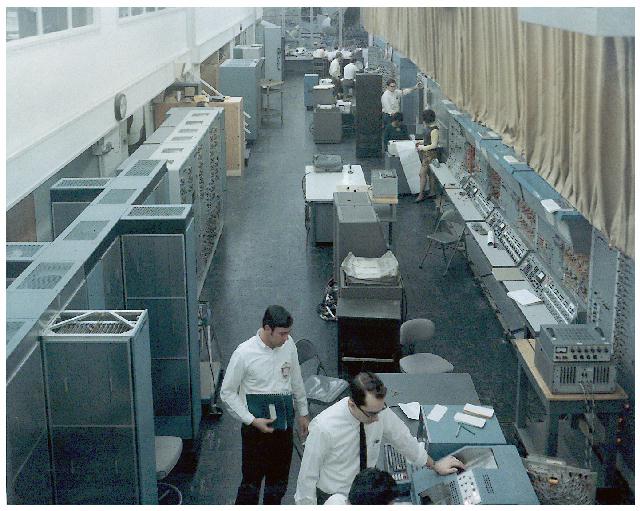The Martin-Marietta Aerospace Simulation and Test Laboratory
|
First of all, I would like to thank Mr. Bruce Baker who kindly provided the pictures and scans shown in the following as well as a lot of interesting background information about these systems and especially the EAI 231R-V analog computer. The picture below shows the "Tactical Avionics System Simulator" at Ft. Monmouth, New Jersey. According to Mr. Baker, he is "the guy near the bottom of the picture with his hand on the card reader". Visible in this picture are some EAI 231R systems, two 231R-V, a DOS-350 (the digital part of a Hydac 2000 hybrid computer - the analog part of such a machine was a 231R(-V)) and, finally, a DDP-24. The machine on the lower left is an EAI 8400, a 32 bit floating point machine.

Mr. Baker started working for Martin-Marietta in 1970 - W When Mr. Baker started working for Martin-Marietta, this was what he found there: "I was fortunate to have had the opportunity to work with the 231R-V analog computers for many years. I started at Martin Marietta in 1970, and the 231R-V computers were still relatively new, although not many years later EAI stopped providing any parts or service for them as they wanted everyone to buy new machines." "When I started at MM, the simulation lab had two 231R computers that were in a sorry state of repair and calibration. These machines had all hand set pots. Sometime in the early 70s we got money to update the lab and bought a Sigma 5 digital computer and updated the analog computers. Because all the analog computers were different, I had the technicians rewire all of them to make them all the same. EAI custom engineered most of the 231Rs and it wasn't until about 1964 that they had anything resembling a standard patch panel layout." "I bought several surplus machines for parts, and began making the machines so that they were all the same. The other simulation lab at MM had 6 231R-Vs, and they gave us 3 of them. However, these were not the gems, but had all hand set pots and no resolvers. Some of the surplus machines I purchased had servo set pots, and so we converted everything to servo set pots. We also had enough parts to put 3 good high accuracy resolvers on each machine. We built our first trunking station about this time. We used a single 231R and put two patch panels on it, with the two patch panels wired in parallel. This allowed the analog computers access to all the other equipment in the lab without the necessity to move cables around under the floor. It really worked out well. It still had the readout system and DVM, so it made debugging really easy." |
|
Here is a paper describing the Martin-Marietta Aerospace Simulation and Test Laboratory (thanks to Marc de Piolenc for enhancing the scans and creating a PDF file). |
| 05-NOV-2006, 27-JAN-2008, 28-OCT-2012 |